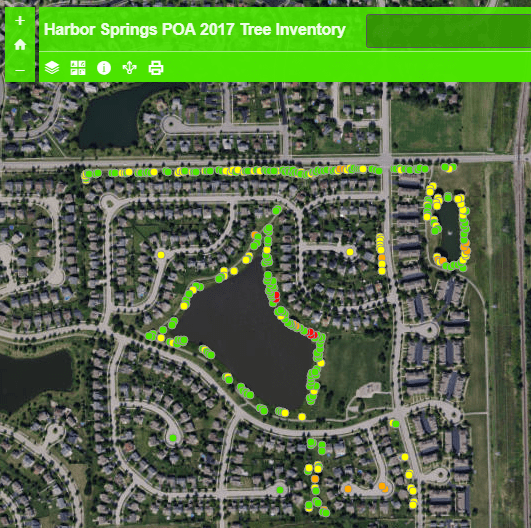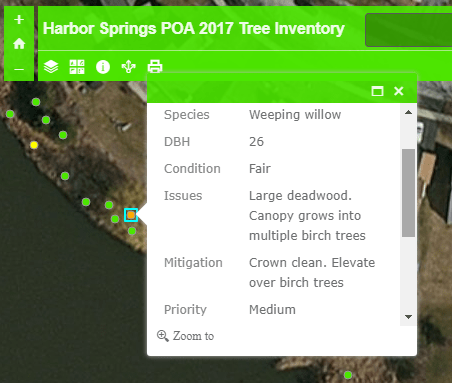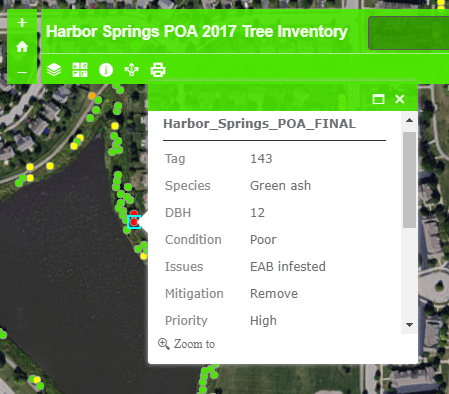Do you manage a community association with numerous and/or aging trees? Chances are, you‘ve had to contend with unexpected tree care costs, and perhaps damage to structures or other property resulting from failed tree limbs. You want to head off future problems and preserve the beauty of your community’s treescape. But where to begin?.
Start with a tree inventory.
A professional tree inventory and management plan is the most efficient and cost-effective way to care for your trees and keep your community attractive and safe. It can help your association avoid expensive emergency tree services, reduce risk to people and property, and build a data-based care plan tailored to your priorities and budget.
A professional tree inventory is a detailed report prepared by a certified arborist that lists and describes all the trees and their locations within the specified areas on your property. The assessment of an individual tree consists of a 360-degree, ground-based visual inspection of the tree’s crown, trunk, and above-ground roots. The inventory captures a range of useful data for each tree, including its location, species, age, condition, defects, recommended action, and a priority rating for each recommendation – e.g., “high,” “medium,” or “low” priority of action, or “no action needed at this time.”

Due to advancements in technology, tree inventory and management plans are now remarkably functional and accessible. In addition to a written report of the data and recommendations in the tree inventory, the information is also provided on a cloud-based application that can be easily accessed by the property manager, the homeowner’s board, and the tree-care professionals hired to do the work.
The many benefits of a tree inventory
The scope of a tree inventory should be tailored to your community’s specific concerns and goals. The focus can be strictly on risk assessment – identifying dead or failing trees that pose a potential risk to people and property — or can more broadly address the health conditions, suggested interventions, and recommended maintenance of the community’s tree canopy. Here are some of the advantages of having an inventory done in your community…
 Safety. An expertly-prepared tree inventory will warn you of the potential for tree failure due to pests or disease.
Safety. An expertly-prepared tree inventory will warn you of the potential for tree failure due to pests or disease.
Data-based decision-making. A tree inventory helps your association make clear-eyed spending decisions based on the specific conditions of your trees – i.e., which dead or decayed trees should be removed immediately, which trees with disease or pest problems can be treated to save or extend their life, which healthy trees can be treated to prevent problems.
Budgeting. The risk ratings and other useful data points on the inventory help the association and its tree care professional establish a scope and timetable for the tree work based on the priority ratings of the recommendations, the estimated costs, and the association’s budget.
 Bidding and completing the work. The detailed inventory report – in its print and web-accessed (mobile-friendly) formats — becomes a concrete working plan for the property manager and Board to use to solicit cost proposals, and for the tree-care professionals you hire to perform the work.
Bidding and completing the work. The detailed inventory report – in its print and web-accessed (mobile-friendly) formats — becomes a concrete working plan for the property manager and Board to use to solicit cost proposals, and for the tree-care professionals you hire to perform the work.
Guidance on new plantings. Because the inventory report provides a breakdown by tree species — and highlights any over-represented species — it serves as a guide for new plantings to ensure species diversity that will protect your landscape from devastation from a single pest or disease.
Two details from web-based site map: Simply tapping on the screen of a phone or tablet allows the viewer to get detail on a specific tree, with all of the attributes that were captured as part of the tree plan. The map can be searched by tree tag number or species. [Photo credit: SavATree Consulting Group]
Take the First Step.
Arrange to meet with a certified arborist to discuss your goals for a tree inventory. Once you have a tree inventory in hand, you can work with your tree care professional to devise a comprehensive, reasonable, and multi-phased management plan that will help you keep your community’s landscape in the best possible shape for current and future homeowners.



 CAI - Illinois Chapter
CAI - Illinois Chapter 
 Phillip Mariotti
Phillip Mariotti 

